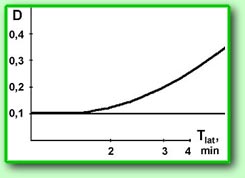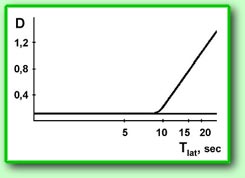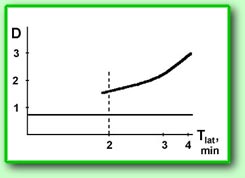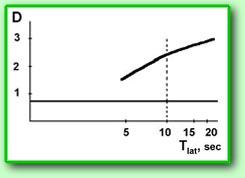|
19. Latensification
In this lesson we shall discuss a very important
property of photographic emulsions – dependence
of sensitivity on exposure conditions.
One of the basic laws of photochemistry – the
so called law of interchangeability (Grotguss-Dreper
law [1] asserts that the
amount of products of the photochemical reaction
depends on the total exposure H, that is on
the product of illumination E by the exposure
time t and doesn’t depend on E and t taken separately.
But soon after elucidation of this regularity
it turned out that the law is true in a rather
narrow range of exposures. As a rule under ordinary
conditions of the day illumination the law is
observed by exposure times from the thousandths
of one second up to hundreds of seconds. Outside
this range sensitivity of the photomaterial
begins to fall. This phenomenon was called the
Schwarzschild effect.
The Schwarzschild effect is especially noticeable
by recording holograms using the pulse neodymium
laser which radiates a supershort pulse with
a duration of about 20 nsec. According to the
Gurney-Mott theory [1] during
this short period of time the photons practically
simultaneously knock out from the crystal of
silver bromide a big number of electrons. They
form an ensemble of very small centers of latent
image literally consisting of several silver
atoms and these centers are located in the lattice
defects of the crystal (dislocations) as in
the potential wells. In connection with their
small sizes these centers can’t create a required
density of darkening by development and hence
brightness of holographic image turns out to
be rather small. Moreover small centers of the
latent image are strongly subject to thermal
fluctuations of the lattice and can be simply
destroyed in the course of time. This happens
with the hologram. If it is developed not immediately
but the next day the latent image can disappear
at all so that development gives nothing. We
have to increase the pulse energy what negatively
affects laser service life and safety of recording
portraits of people.
But in photography another remarkable effect
called latensification is known (from
the latin word “latent”). Nature of this effect
consists in amplification of the latent image
created by a short light pulse with the following
continuous and weak exposure. Gurney-Mott theory
easily explains this effect. By weak exposure
of the silver bromide crystal the electrons
knocked out by photons in small amounts don’t
have time to create new centers of latent image
but they are quickly captured by the centers
of latent image already created by the first
exposure. These centers increase in their sizes
(up to 100 and more atoms of silver) and so
turn into active centers of development. Development
of such centers occurs quickly and density of
darkening of the photographic layer becomes
normal. The most interesting fact in this effect
is that such a weak exposure doesn’t in itself
exert influence on the photographic layer that
is it doesn’t cause darkening by development
and in such a way it doesn't worsen quality
of the hologram. It can only intensify the first
pulse exposure.
Let us go over to determination of the optimum
time of latensification [2].
For our setup a photographic lantern with a
mat bulb 40 Watt and with a green filter or
without it was used. The distance between the
lantern and the hologram was equal to 80 cm.
The photoplate was cut into several small pieces.
All pieces but one were in turn placed at the
prescribed distance from the lantern and were
exposed during different time intervals. Not
exposed part is necessary for evaluation of
the photoplate density veil. Then all parts
were developed in the same developing tray and
fixed (formulas of solutions will be given in
the next lesson). All parts will have different
density of blackening. Optimum time of latensification
is determined as a time by which density of
blackening of the latensified photoplate begins
to exceed the veil density which is determined
using the not exposed plate.
 |
 |
In the fig. above the dependences of darkening
density of the test photographic plates on the
latensification time averaged by two series
are shown. The horizontal line on the graph
is a veil density of the photoplates used in
the experiment. As can be seen from the graph
optimum time of latensification is equal to
2 min. for the lantern with a green filter and
10 sec. for the lantern without a filter.
 |
 |
In the fig. above the dependences of darkening
density of the exposed holograms on the latensification
time averaged by two series are shown. Horizontal
line is a darkening density of the exposed hologram
without latensification. It follows from the
graph that optimum latensification secures increase
of opacity of the exposed photoplate approximately
by a factor of ten (D=1). From this point of
view we can speak about tenfold increase of
sensitivity of the VRP photoplates. Visual evaluation
of quality of the restored image on the whitened
holograms has shown a significant increase of
the image brightness by latensification of the
hologram. Type of the latensification source
didn’t affect quality of the hologram. And another
advantage of latensification, which can't be
totally explained, consists in the following:
after latensification uniformity of the reference
beam across the field of the photoplate increases.
This fact has a positive influence on uniformity
of brightness of the restored image when it
is observed from various points of view within
the observation zone.
References
1. T. H. James, The Theory of the Photographic
Process, Macmillan Publishing Co., New York,
1977.
2. Sergey P. Vorobyov, The sensitization of
VR-P Russian photoplates for recording pulsed
holograms, SPIE, v. 3358, 1997, p. 67.
-->
|





